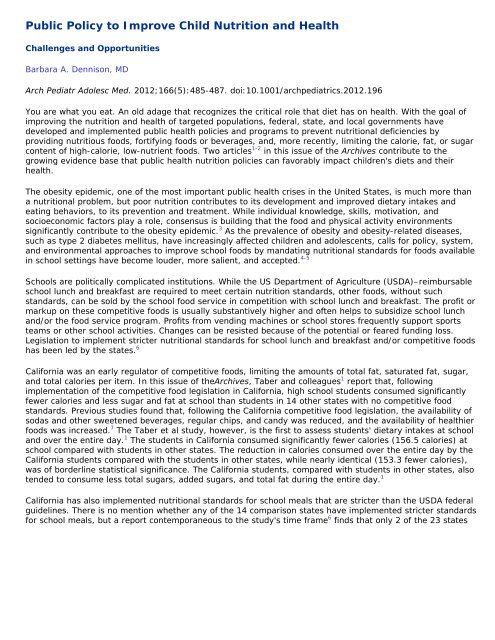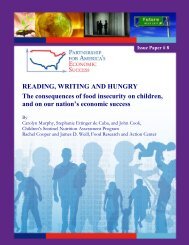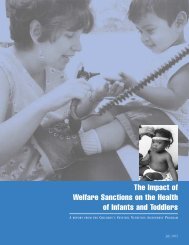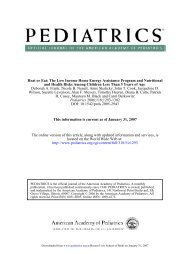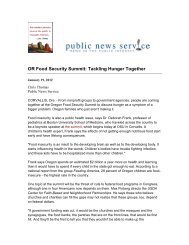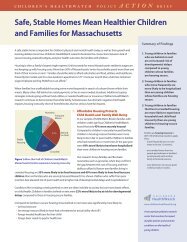Public Policy to Improve Child Nutrition and Health - Children's ...
Public Policy to Improve Child Nutrition and Health - Children's ...
Public Policy to Improve Child Nutrition and Health - Children's ...
You also want an ePaper? Increase the reach of your titles
YUMPU automatically turns print PDFs into web optimized ePapers that Google loves.
<strong>Public</strong> <strong>Policy</strong> <strong>to</strong> <strong>Improve</strong> <strong>Child</strong> <strong>Nutrition</strong> <strong>and</strong> <strong>Health</strong>Challenges <strong>and</strong> OpportunitiesBarbara A. Dennison, MDArch Pediatr Adolesc Med. 2012;166(5):485-487. doi:10.1001/archpediatrics.2012.196You are what you eat. An old adage that recognizes the critical role that diet has on health. With the goal ofimproving the nutrition <strong>and</strong> health of targeted populations, federal, state, <strong>and</strong> local governments havedeveloped <strong>and</strong> implemented public health policies <strong>and</strong> programs <strong>to</strong> prevent nutritional deficiencies byproviding nutritious foods, fortifying foods or beverages, <strong>and</strong>, more recently, limiting the calorie, fat, or sugarcontent of high-calorie, low-nutrient foods. Two articles 1-2 in this issue of the Archives contribute <strong>to</strong> thegrowing evidence base that public health nutrition policies can favorably impact children's diets <strong>and</strong> theirhealth.The obesity epidemic, one of the most important public health crises in the United States, is much more thana nutritional problem, but poor nutrition contributes <strong>to</strong> its development <strong>and</strong> improved dietary intakes <strong>and</strong>eating behaviors, <strong>to</strong> its prevention <strong>and</strong> treatment. While individual knowledge, skills, motivation, <strong>and</strong>socioeconomic fac<strong>to</strong>rs play a role, consensus is building that the food <strong>and</strong> physical activity environmentssignificantly contribute <strong>to</strong> the obesity epidemic. 3 As the prevalence of obesity <strong>and</strong> obesity-related diseases,such as type 2 diabetes mellitus, have increasingly affected children <strong>and</strong> adolescents, calls for policy, system,<strong>and</strong> environmental approaches <strong>to</strong> improve school foods by m<strong>and</strong>ating nutritional st<strong>and</strong>ards for foods availablein school settings have become louder, more salient, <strong>and</strong> accepted. 4-5Schools are politically complicated institutions. While the US Department of Agriculture (USDA)–reimbursableschool lunch <strong>and</strong> breakfast are required <strong>to</strong> meet certain nutrition st<strong>and</strong>ards, other foods, without suchst<strong>and</strong>ards, can be sold by the school food service in competition with school lunch <strong>and</strong> breakfast. The profit ormarkup on these competitive foods is usually substantively higher <strong>and</strong> often helps <strong>to</strong> subsidize school lunch<strong>and</strong>/or the food service program. Profits from vending machines or school s<strong>to</strong>res frequently support sportsteams or other school activities. Changes can be resisted because of the potential or feared funding loss.Legislation <strong>to</strong> implement stricter nutritional st<strong>and</strong>ards for school lunch <strong>and</strong> breakfast <strong>and</strong>/or competitive foodshas been led by the states. 6California was an early regula<strong>to</strong>r of competitive foods, limiting the amounts of <strong>to</strong>tal fat, saturated fat, sugar,<strong>and</strong> <strong>to</strong>tal calories per item. In this issue of theArchives, Taber <strong>and</strong> colleagues 1 report that, followingimplementation of the competitive food legislation in California, high school students consumed significantlyfewer calories <strong>and</strong> less sugar <strong>and</strong> fat at school than students in 14 other states with no competitive foodst<strong>and</strong>ards. Previous studies found that, following the California competitive food legislation, the availability ofsodas <strong>and</strong> other sweetened beverages, regular chips, <strong>and</strong> c<strong>and</strong>y was reduced, <strong>and</strong> the availability of healthierfoods was increased. 7 The Taber et al study, however, is the first <strong>to</strong> assess students' dietary intakes at school<strong>and</strong> over the entire day. 1 The students in California consumed significantly fewer calories (156.5 calories) atschool compared with students in other states. The reduction in calories consumed over the entire day by theCalifornia students compared with the students in other states, while nearly identical (153.3 fewer calories),was of borderline statistical significance. The California students, compared with students in other states, alsotended <strong>to</strong> consume less <strong>to</strong>tal sugars, added sugars, <strong>and</strong> <strong>to</strong>tal fat during the entire day. 1California has also implemented nutritional st<strong>and</strong>ards for school meals that are stricter than the USDA federalguidelines. There is no mention whether any of the 14 comparison states have implemented stricter st<strong>and</strong>ardsfor school meals, but a report contemporaneous <strong>to</strong> the study's time frame 6 finds that only 2 of the 23 states
with no st<strong>and</strong>ards for competitive foods had st<strong>and</strong>ards for school meals stricter than the USDA requirements.Thus, the differences in the school dietary intakes between the California students <strong>and</strong> the students in thecomparison states reflect the impact of both school meals <strong>and</strong> competitive foods st<strong>and</strong>ards. It is also likelythat states that have passed legislation <strong>to</strong> require healthier foods may also be more supportive of othernutrition policies <strong>and</strong> have different levels of concern about child obesity <strong>and</strong> in the roles of schools <strong>and</strong>government in addressing the school food environment.This study supports <strong>and</strong> contributes <strong>to</strong> the emerging public health evidence base that students' dietaryintakes will improve if less healthful foods <strong>and</strong> beverages are not permitted in schools. More studies such asthis are needed <strong>to</strong> underst<strong>and</strong> the myriad of existing state competitive food legislation already implemented<strong>to</strong> help inform the federal competitive food legislation currently in development. These studies need <strong>to</strong>measure change in students' dietary intakes but also changes in nutritional quality, weight status, growth,<strong>and</strong> health measures. <strong>Public</strong> health evaluations such as this are hard <strong>to</strong> do, as reflected in the relatively lowparticipation rate of 24.7%.Of greater concern, however, are the students' low reported caloric intakes. The students' average caloricintakes at school (353 calories in California <strong>and</strong> 509 calories in the comparison states) are much lower than anational study of school lunch (733 calories for high school national school lunch participants <strong>and</strong> 661 caloriesfor nonparticipants). 8 The average daily caloric intakes (1639 calories/d in California <strong>and</strong> 1792 calories/d inthe comparison states) are also much lower than a national study (National <strong>Health</strong> <strong>and</strong> <strong>Nutrition</strong> ExaminationSurvey 1999-2000: average daily intake was 2700 calories/d for males aged 12-19 years <strong>and</strong> 2000 calories/dfor females aged 12-19 years). 9 These low reported intakes most likely represent underreporting; whether theunderreporting differs between California <strong>and</strong> the other states is not known. Nonetheless, if the 150-kcal/ddifference between students in California <strong>and</strong> other states is "real" <strong>and</strong> not compensated on nonschool days,the accumulated deficit over the typical 180-day school year would translate <strong>to</strong> a difference of about 7.7pounds/y. Anthropometric measures were not part of this study but in the future need <strong>to</strong> be included, asreducing excess weight gain <strong>and</strong> obesity are primary targets of school policy <strong>and</strong> environmental changes.With passage of the federal <strong>Health</strong>y, Hunger-Free Kids Act of 2010, schools are required <strong>to</strong> adhere <strong>to</strong> newst<strong>and</strong>ards <strong>to</strong> improve the quality of school meals, <strong>and</strong> schools that comply will be eligible for increased federalreimbursements for school meal programs. 10 Beginning with the 2012-2013 school year, the USDAreimbursableschool lunch will need <strong>to</strong> include more fruits <strong>and</strong> vegetables, whole grains, <strong>and</strong> reduced-fat milk.In addition <strong>to</strong> st<strong>and</strong>ards for school meals, the USDA is required <strong>to</strong> establish nutritional st<strong>and</strong>ards for all otherfoods <strong>and</strong> beverages (ie, competitive foods) served or sold in schools at any time during the day throughoutthe school campus, including vending machines, school s<strong>to</strong>res, <strong>and</strong> à la carte in the cafeteria. An expertcommittee has recommended that if competitive foods are available in schools, they should be limited <strong>to</strong>foods that youth need <strong>to</strong> consume more, ie, fruits, vegetables, whole grains, <strong>and</strong> nonfat or low-fat milk <strong>and</strong>dairy products. 4 However, as was demonstrated in developing the new nutritional st<strong>and</strong>ards for school lunch<strong>and</strong> breakfast, the interests of industry <strong>and</strong> advocates can influence the interpretation of science, translationin<strong>to</strong> specific rules, <strong>and</strong> implementation time frames.As pointed out by Robinson, 11 we need <strong>to</strong> build the evidence about what policy changes will work under whatcircumstances <strong>and</strong> in which types of schools or populations. As exciting as the thought of r<strong>and</strong>omizing states,cities, or school districts in a policy change trial, it is incredibly unlikely that states, cities, or school districtswould ever agree <strong>to</strong> be r<strong>and</strong>omized <strong>to</strong> test the implementation <strong>and</strong> impact of a new policy. Perhaps funding orthe provision of training <strong>and</strong> technical assistance could be r<strong>and</strong>omized or staggered. A robust, comprehensiveevaluation plan needs <strong>to</strong> be in place <strong>to</strong> document the implementation <strong>and</strong> fidelity <strong>and</strong> <strong>to</strong> measure the process<strong>and</strong> outcome changes. Nonetheless, we are at the cusp of widespread implementation of major nutritionpolicies. As these policy changes are implemented in schools, it is essential <strong>to</strong> have a better underst<strong>and</strong>ing ofwhat policies are currently in place in different schools <strong>and</strong> states; what are students' current diets <strong>and</strong>weight status; what policy changes are being implemented; what is the effect on the school food environment<strong>and</strong> students' dietary intakes in school, outside of school, <strong>and</strong> over a longer period; <strong>and</strong> what is the impact on
children's nutrition, growth, weight status, <strong>and</strong> health.A separate study 2 in the Archives reports additional benefits among those participating in the federally fundedpublic health nutrition program the Special Supplemental <strong>Nutrition</strong> Program for Women, Infants, <strong>and</strong> <strong>Child</strong>ren(WIC). Among 26 950 low-income primary caretakers of young children (
implementation <strong>and</strong> guide further recommendations. Our children deserve nothing less.AUTHOR INFORMATIONCorrespondence: Dr Dennison, <strong>Health</strong> <strong>Policy</strong> <strong>and</strong> Research Translation Unit, Division of Chronic DiseasePrevention, New York State Department of <strong>Health</strong>, Corning Tower, Ste 515, Empire State Plaza, Albany, NY12237 (bad10@health.state.ny.us).Financial Disclosure: None reported.Author Affiliations: Department of Epidemiology <strong>and</strong> Statistics, School of <strong>Public</strong> <strong>Health</strong>, University atAlbany, State University of New York, <strong>and</strong> <strong>Health</strong> <strong>Policy</strong> <strong>and</strong> Research Translation Unit, Division of ChronicDisease Prevention, New York State Department of <strong>Health</strong>, Albany.REFERENCES1. Taber DR, Chriqui JF, Chaloupka FJ. Differences in nutrient intake associated with state laws regarding fat,sugar, <strong>and</strong> caloric content of competitive foods. Arch Pediatr Adolesc Med.2012;166(5):452-458. FREE FULL TEXT2. Black MM, Quigg AM, Cook J; et al. WIC participation <strong>and</strong> attenuation of stress-related child health risks ofhousehold food insecurity <strong>and</strong> caregiver depressive symp<strong>to</strong>ms. Arch Pediatr Adolesc Med. 2012;166(5):444-451. FREE FULL TEXT3. S<strong>to</strong>ry M, Kaphingst KM, Robinson-O’Brien R, Glanz K. Creating healthy food <strong>and</strong> eating environments:policy <strong>and</strong> environmental approaches. Annu Rev <strong>Public</strong> <strong>Health</strong>. 2008;29:253-272.FULL TEXT | WEB OFSCIENCE | PUBMED4. Stallings VA, ed, Yaktine AL, ed. Institute of Medicine. <strong>Nutrition</strong> St<strong>and</strong>ards for Foods in Schools: Leadingthe Way Toward <strong>Health</strong>ier Youth. Washing<strong>to</strong>n, DC: The National Academies Press; 2007.5. Mello MM, Studdert DM, Brennan TA. Obesity: the new frontier of public health law. N Engl JMed. 2006;354(24):2601-2610. FULL TEXT | WEB OF SCIENCE | PUBMED
6. Levi J, Vinter S, Richardson L; et al. F as in fat: how obesity threatens America's future2009. http://healthyamericans.org/reports/obesity2009/Obesity2009Report.pdf. Accessed February 10, 2012.7. Woodward-Lopez G, Gosliner W, Samuels SE, Craypo L, Kao J, Crawford PB. Lessons learned fromevaluations of California's statewide school nutrition st<strong>and</strong>ards. Am J <strong>Public</strong> <strong>Health</strong>.2010;100(11):2137-2145. FULL TEXT | PUBMED8. Gordon A, Fox MK, Clark M; et al. School <strong>Nutrition</strong> Dietary Assessment Study III. Volume II: StudentParticipation <strong>and</strong> Dietary Intakes. Alex<strong>and</strong>ria, VA: USDA, Food <strong>and</strong> <strong>Nutrition</strong> Service;2007:154. http://www.fns.usda.gov/ora/menu/published/CNP/FILES/SNDAIII-Vol2.pdf. Accessed February10, 2012.9. Centers for Disease Control <strong>and</strong> Prevention. Intake of calories <strong>and</strong> selected nutrients for the United Statespopulation, 1999-2000.http://www.cdc.gov/nchs/data/nhanes/databriefs/calories.pdf. Accessed February 10,2012.10. <strong>Health</strong>y, Hunger-Free Kids Act of 2010. USDAwebsite. http://www.fns.usda.gov/cnd/Governance/Legislation/CNR_2010.htm. Accessed February 10, 2012.11. Robinson TN. Solution-oriented policy research: using research <strong>to</strong> drive obesity prevention <strong>and</strong> controlpolicies. Arch Pediatr Adolesc Med. 2012;166(2):189-190. FREE FULL TEXT12. Black MM, Cutts DB, Frank DA; et al, <strong>Child</strong>ren's Sentinel <strong>Nutrition</strong>al Assessment Program Study Group.Special Supplemental <strong>Nutrition</strong> Program for Women, Infants, <strong>and</strong> <strong>Child</strong>ren participation <strong>and</strong> infants' growth<strong>and</strong> health: a multisite surveillance study. Pediatrics. 2004;114(1):169-176. FREE FULL TEXT13. US Department of Agriculture, Food <strong>and</strong> <strong>Nutrition</strong> Service, Office of Research <strong>and</strong> Analysis. National <strong>and</strong>State-Level Estimates of Special Supplemental <strong>Nutrition</strong> Program for Women, Infants, <strong>and</strong> <strong>Child</strong>ren (WIC)Eligibles <strong>and</strong> Program Reach, 2000–2009. Alex<strong>and</strong>ria, VA: US Department of Agriculture, Food <strong>and</strong> <strong>Nutrition</strong>Service, Office of Research <strong>and</strong> Analysis; 2011.
Department of Agriculture, Economic Research Service; 2009. Report 73.15. Committee <strong>to</strong> Review the WIC Food Packages, Institute of Medicine. WIC Food Packages: Time for aChange. Washing<strong>to</strong>n, DC: The National Academies Press; 2005.16. US Department of Agriculture, Food <strong>and</strong> <strong>Nutrition</strong> Service, Office of Research <strong>and</strong> Analysis. WICBreastfeeding Peer Counseling Study, Final Implementation Report. Alex<strong>and</strong>ria, VA: US Department ofAgriculture, Food <strong>and</strong> <strong>Nutrition</strong> Service, Office of Research <strong>and</strong> Analysis; 2010. WIC-10-BPC.CiteULike Connotea Delicious Digg Facebook Reddit Technorati Twitter What's this?RELATED ARTICLESWIC Participation <strong>and</strong> Attenuation of Stress-Related <strong>Child</strong> <strong>Health</strong> Risks of Household FoodInsecurity <strong>and</strong> Caregiver Depressive Symp<strong>to</strong>msMaureen M. Black, Anna M. Quigg, John Cook, Patrick H. Casey, Diana Becker Cutts, Mariana Chil<strong>to</strong>n, AlanMeyers, Stephanie Ettinger de Cuba, Timothy Heeren, Sharon Coleman, Ruth Rose-Jacobs, <strong>and</strong> Deborah A.FrankArch Pediatr Adolesc Med. 2012;166(5):444-451.ABSTRACT | FULL TEXTDifferences in Nutrient Intake Associated With State Laws Regarding Fat, Sugar, <strong>and</strong> CaloricContent of Competitive FoodsDaniel R. Taber, Jamie F. Chriqui, <strong>and</strong> Frank J. ChaloupkaArch Pediatr Adolesc Med. 2012;166(5):452-458.ABSTRACT | FULL TEXT


